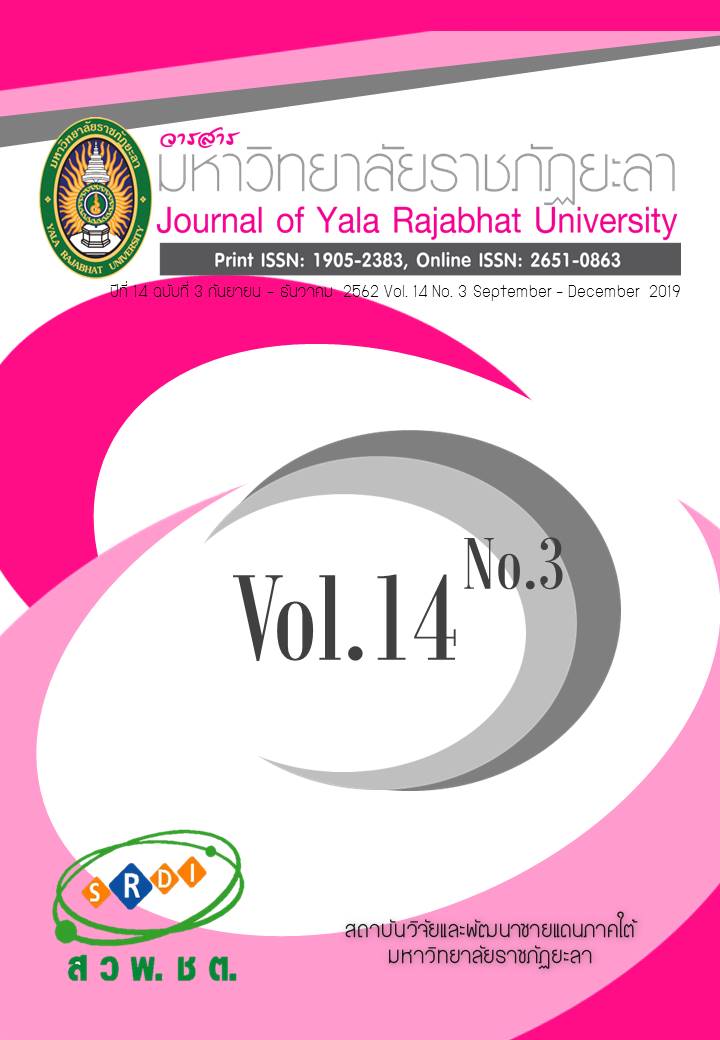โมเดลการวัดทักษะชีวิตของนักเรียนชั้นมัธยมศึกษายุคไทยแลนด์ 4.0 ในจังหวัดสระแก้ว
Main Article Content
บทคัดย่อ
ทักษะชีวิตมีความสำคัญกับยุคไทยแลนด์ 4.0 การวิจัยในครั้งนี้มีวัตถุประสงค์เพื่อพัฒนา และตรวจสอบองค์ประกอบเชิงยืนยันทักษะชีวิตของนักเรียนชั้นมัธยมศึกษายุคไทยแลนด์ 4.0 ในจังหวัดสระแก้วกับข้อมูลเชิงประจักษ์ กลุ่มตัวอย่างที่ใช้ในการวิจัยได้มาโดยการสุ่มแบบอย่างง่าย จำนวน 500 คน เครื่องมือที่ใช้เป็น แบบสอบถามทักษะชีวิตสำหรับนักเรียนชั้นมัธยมศึกษา การวิเคราะห์ข้อมูลใช้การวิเคราะห์องค์ประกอบเชิงยืนยัน โดยใช้โปรแกรมลิสเรล ผลการวิจัยปรากฏว่า โมเดลองค์ประกอบทักษะชีวิตของนักเรียนชั้นมัธยมศึกษายุคไทยแลนด์ 4.0 ในจังหวัดสระแก้วที่พัฒนาขึ้นประกอบด้วย 2 องค์ประกอบ ได้แก่ องค์ประกอบที่ 1 ทักษะชีวิตด้านทักษะทางปัญญาอย่างมีวิจารณญาณ และองค์ประกอบที่ 2 ทักษะชีวิตด้านสังคมและอารมณ์ แบ่งเป็น 10 ด้าน ได้แก่ การคิดสร้างสรรค์ การคิดอย่างมีวิจารณญาณ การตัดสินใจ การแก้ไขปัญหา การสื่อสารอย่างมีประสิทธิภาพความตระหนักในตนเอง การเห็นอกเห็นใจผู้อื่น ทักษะความสัมพันธ์ระหว่างบุคคล การจัดการความเครียด และการจัดการอารมณ์ มีความสอดคล้องกับข้อมูลเชิงประจักษ์ จากผลการวิเคราะห์องค์ประกอบเชิงยืนยัน ค่าน้ำหนักทักษะชีวิตทั้ง 10 ด้าน มีค่าเป็นบวก ค่าน้ำหนักองค์ประกอบอยู่ระหว่าง .50 ถึง .84 และมีนัยสำคัญทางสถิติที่ระดับ .01 ด้านเหล่านี้อยู่ในองค์ประกอบทักษะชีวิตทั้ง 2 องค์ประกอบ ดังนี้ องค์ประกอบที่ 1 ทักษะชีวิตด้านทักษะทางปัญญาอย่างมีวิจารณญาณ มีค่าน้ำหนักองค์ประกอบอยู่ระหว่าง .62 ถึง .81 โดยที่ด้านที่ค่าน้ำหนักมากที่สุด ได้แก่ ทักษะการคิดอย่างมีวิจารณญาณ ส่วนองค์ประกอบที่ 2 ทักษะชีวิตด้านสังคมและอารมณ์ มีค่าน้ำหนักองค์ประกอบอยู่ระหว่าง .50 ถึง .84 โดยที่ด้านที่ค่าน้ำหนักมากที่สุดได้แก่ ทักษะการเข้าใจผู้อื่น
Article Details
บทความ ข้อมูล เนื้อหา รูปภาพ ฯลฯ ที่ได้รับการเผยแพร่ในวารสารมหาวิทยาลัยราชภัฏยะลานี้ ถือเป็นลิขสิทธิ์ของวารสารมหาวิทยาลัยราชภัฏยะลา หากบุคคลหรือหน่วยงานใดต้องการนำทั้งหมดหรือส่วนหนึ่งส่วนใดไปเผยแพร่ต่อหรือกระทำการใดๆ จะต้องได้รับอนุญาตเป็นลายลักษณ์อักษรจากวารสารมหาวิทยาลัยราชภัฏยะลาก่อนเท่านั้น
เอกสารอ้างอิง
2. Elias, M. J., Gara, M. A., Schuyler, T. F., Branden-Muller, L. R. & Sayette, M. A. (1991). The promotion of social competence: longitudinal study of a preventive school-based program. American Journal of Orthopsychiatry, 61(3), 409-417.
3. Feindler, E. L., Ecton, R. B., Kingsley, D. & Dubey, D. R. (1986). Group anger-control training for institutionalized psychiatric male adolescents. Behavior Therapy, 17(2), 109-123. doi:http://dx.doi.org/10.1016/S0005-7894(86)80079-X
4. Jareonsetsil, T. (2016). Policy focus Minister of Education [Online]. Retrieved October 3, 2016, from: http://bps.sueksa.go.th. (in Thai)
5. Komjakraphan, P., Balthip, Q., Naka, K. & Piriyakunthon, S. (2017). Development of the Harmony of Life Scale. Journal of Yala Rajabhat University, 12(Suppl.), 73-85. (in Thai)
6. Kongvimon, S., Thepsaeng, S. & Chatkamonthat, S. (2015). The Strategies of Developing for Student’s Life Skills. SWU educational administration journal, 12(22), 13 -22. (in Thai)
Macmillan Education. (2015). Income inequality, intergenerational mobility, and the Great Gatsby Curve: is education the key?. Social Forces, 94(2), 505-533.
7. Maryam, E., Mohamadi, M. D., Zahra, G. & Bahram, I. (2011). Effectiveness of life skills training onincreasing self-esteem of high school students. Procedia - Social and Behavioral Sciences, 30, 1043-1047.
8. Mungmueng, S. (2012). Lesson Plans: Life Skills. Bangkok: Sootpaisanbewder. (in Thai).
9. Office of the Basic Education Commission. (2016). Basic Information [Online]. Retrieved June 10, 2016, from: http://www.moe.go.th. (in Thai)
10. Pallant, J. (2013). SPSS Survival Manual: A Step by Step Guide to Data Analysis Using the SPSS Program (5th ed.). Maidenhead, Berkshire, England: McGraw-Hill.
11. Pipattanawong, W. (2014). Life Skills of Thai Teen in the 21st Century. Payap university journal, 24(2), 39 -63. (in Thai)
12. Polit, D. F., Beck, C.T. (2007). Focus on Research Methods Is the CVI an Acceptable Indicator of Content Validity? Appraisal and Recommendations. Research in Nursing & Health, 30, 459–467.
13. Rahmati, B., Adibrad, N., Tahmasian, K. & sedghpour, B. S. (2010).The Effectiveness of life skill training on Social adjustment in Children. Procedia - Social and Behavioral Sciences, 5, 870-874. doi:http://dx.doi.org/10.1016/j.sbspro.2010.07.201
14. Ramesht, M. & Farshad, C. (2009). Study of life skills training in prevention of drug abuse in students [Online]. Retrieved May 25, 2009, from: https://www.ncbi.nlm.nih.gov/pmc/articles/PMC4105605/.
15. Smith, E. A., Swisher, J. D., Vicary, J. R., Bechtel, L. J., Minner, D., Henry, K. L., et al. (2004). Evaluation of life skills training and infused-life skills training in a rural setting: outcomes at two years. J Alcohol Drug Educ, 48, 51-70.
16. Voracharoensri, S. (2007). A Study of Life Skills and A Training Group Model Construction for Developing Life Skills of Adolescent Students. Dissertation, Ed.D. (Counseling Psychology), Srinakharinwirot University. (in Thai)
17. Wongpiromsan, Y. & Ruengkanjanaset., S. (2009). Life Skills. Bangkok: Thaihealth Info Center. (in Thai)
18. World Education. (2015). World Education Forum 2015 FINAL REPORT [Online]. Retrieved May 15 2015, from: http://unesdoc.unesco.org/images/0024/002437/243724e.pdf.
19. World Health Organization. (1997). Life Skill Education For Children and Adolescents in school. Geneva: World Health Organization.
20. Young, D. L., Goodie, A. S., Hall, D. B. & Wu, E. (2012). Decision making under time pressure, modeled in a prospect theory framework. Organ. Behav. Hum. Decis. Process, 118, 179–188. doi: 10.1016/j.obhdp.2012.03.00.


